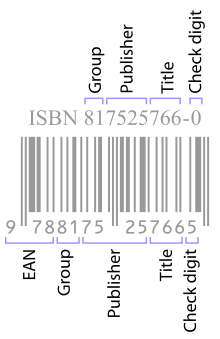Know About ISBN number
The International Standard Book Number (ISBN) is a numeric commercial book identifier which is intended to be unique. Publishers purchase ISBNs from an affiliate of the International ISBN Agency.
An ISBN is assigned to each separate edition and variation (except reprintings) of a publication. For example, an e-book, a paperback and a hardcover edition of the same book will each have a different ISBN. The ISBN is ten digits long if assigned before 2007, and thirteen digits long if assigned on or after 1 January 2007. The method of assigning an ISBN is nation-specific and varies between countries, often depending on how large the publishing industry is within a country.
An ISBN is assigned to each separate edition and variation (except reprintings) of a publication. For example, an e-book, a paperback and a hardcover edition of the same book will each have a different ISBN. The ISBN is ten digits long if assigned before 2007, and thirteen digits long if assigned on or after 1 January 2007. The method of assigning an ISBN is nation-specific and varies between countries, often depending on how large the publishing industry is within a country.
History of ISBN number
The initial ISBN identification format was devised in 1967, based upon the 9-digit Standard Book Numbering (SBN) created in 1966. The 10-digit ISBN format was developed by the International Organization for Standardization (ISO) and was published in 1970 as international standard ISO 2108 (the 9-digit SBN code can be converted to a 10-digit ISBN by prefixing it with a zero digit '0'). Privately published books sometimes appear without an ISBN. The International ISBN Agency sometimes assigns such books ISBNs on its own initiative.
A separate ISBN is assigned to each edition and variation (except reprintings) of a publication. For example, an ebook, audiobook, paperback, and hardcover edition of the same book will each have a different ISBN assigned to it. The ISBN is thirteen digits long if assigned on or after 1 January 2007, and ten digits long if assigned before 2007. An International Standard Book Number consists of four parts (if it is a 10-digit ISBN) or five parts (for a 13-digit ISBN).
Section 5 of the International ISBN Agency's official user manual describes the structure of the 13-digit ISBN, as follows:
ISBN is most often used alongside other special identifiers to describe references in Wikipedia, and can help to find the same sources with different descriptions in various language versions (for example different spellings of the title or authors depending on the language).
Section 5 of the International ISBN Agency's official user manual describes the structure of the 13-digit ISBN, as follows:
The parts of a 10-digit ISBN and the corresponding EAN‑13 and barcode. Note the different check digits in each. The part of the EAN‑13 labeled "EAN" is the Bookland country code.
- for a 13-digit ISBN, a prefix element – a GS1 prefix: so far 978 or 979 have been made available by GS1,
- the registration group element (language-sharing country group, individual country or territory),
- the registrant element,
- the publication element, and
- a checksum character or check digit.
ISBN is most often used alongside other special identifiers to describe references in Wikipedia, and can help to find the same sources with different descriptions in various language versions (for example different spellings of the title or authors depending on the language).












